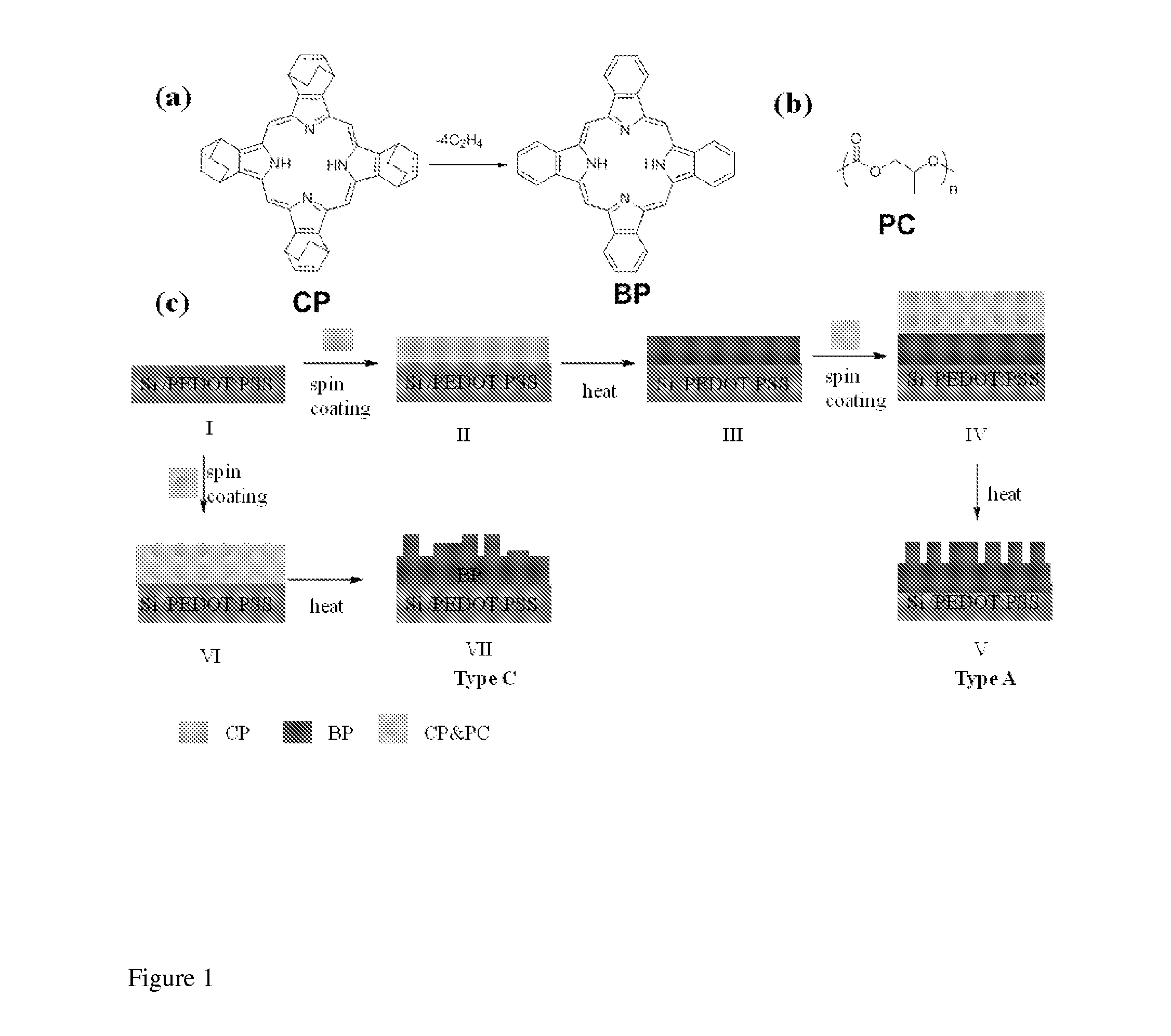Organic Electronic Devices Prepared Using Decomposable Polymer Additives
a technology of organic electronic devices and additives, which is applied in the direction of non-metal conductors, electric/magnetic/electromagnetic heating, conductors, etc., can solve the problems of lowering improve the processability of solar cell devices, and reduce the efficiency/performance of the overall devi
- Summary
- Abstract
- Description
- Claims
- Application Information
AI Technical Summary
Benefits of technology
Problems solved by technology
Method used
Image
Examples
example 1
Fabrication of Device A
[0066]We fabricated device A using the compound in FIG. 3 according to the following procedure. The ITO layer on a glass substrate was 145 nm thick with a sheet resistance of 8 ohms / square. The 5 mm wide stripe pattern on the ITO layer was etched by conventional photolithographic techniques. Prior to the formation of the buffer layer, the patterned ITO glass was ultrasonically cleaned using surfactant, rinsed in deionized water and finished with an air plasma treatment. The PEDOT:PSS (Clevios AI4083) layer was formed on the ITO substrate by spin coating (3,000 rpm) from an aqueous dispersion to give a smooth, 30 nm thick film. The coated PEDOT:PSS layer was baked for 10 minutes at 120° C. in air and annealed for 3 minutes at 195° C. in a nitrogen glove box just prior to use. The solution of 1.0 wt % CP and PC (3:1 weight ratio) in a mixture of chloroform:chlorobenzene (1:1 weight ratio) was spin-cast (1500 rpm) on the PEDOT:PSS layer in a nitrogen glove box. T...
example 2
Fabrication of Device B
[0067]Device B was fabricated in a same way as device A except the process of coating BP layer. BP layer was formed on the PEDOT:PSS layer by spin coating (1500 rpm) from 0.5 wt % CP solution in a mixture of chloroform:chlorobenzene (1:2 weight ratio). Thermal conversion of the CP to BP was then carried out at 195° C. for 20 minutes in a nitrogen glove box. The solution of 1.0 wt % CP and PC (3:1 weight ratio) in a mixture of chloroform:chlorobenzene (1:1 weight ratio) was subsequently spin-cast (1500 rpm) on the thus coated layer in a nitrogen glove box. After that, the device B was fabricated in the same way as device A. The OPV characteristics of device B was summarized in Table 2.
example 3
Fabrication of Device C
[0068]Device C was fabricated in a same way as device B except the solution of CP and PC mixture. The solution for device C was 1.0 wt % CP and PC (3:1 weight ratio) in a mixture of chloroform: 2-chloroethanol (2.5:1 weight ratio). The OPV characteristics of device C was summarized in Table 2.
PUM
| Property | Measurement | Unit |
|---|---|---|
| areas | aaaaa | aaaaa |
| temperature | aaaaa | aaaaa |
| width | aaaaa | aaaaa |
Abstract
Description
Claims
Application Information
 Login to View More
Login to View More - R&D
- Intellectual Property
- Life Sciences
- Materials
- Tech Scout
- Unparalleled Data Quality
- Higher Quality Content
- 60% Fewer Hallucinations
Browse by: Latest US Patents, China's latest patents, Technical Efficacy Thesaurus, Application Domain, Technology Topic, Popular Technical Reports.
© 2025 PatSnap. All rights reserved.Legal|Privacy policy|Modern Slavery Act Transparency Statement|Sitemap|About US| Contact US: help@patsnap.com



